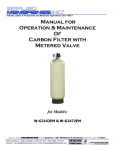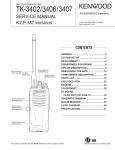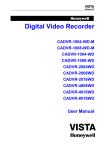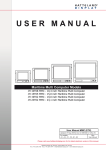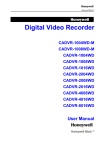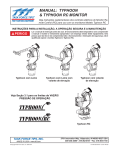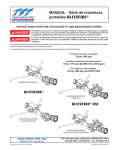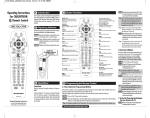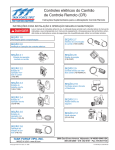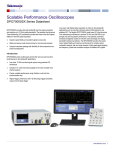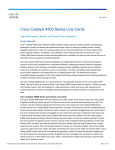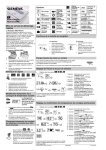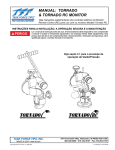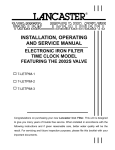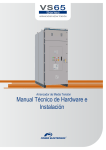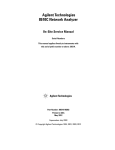Download Crossfire SAFE-TAK Base Instruction Manual
Transcript
MANUAL: CROSSFIRE Monitor INSTRUCTIONS FOR SAFE OPERATION AND MAINTENANCE DANGER Understand manual before use. Operation of this device without understanding the manual and receiving proper training is a misuse of this equipment. Obtain safety information at www.tft com/serial-number. DANGER Risk of sliding increases at low elevation angles. To reduce risk of injury or death from sliding, do not pull elevation pin stop while on portable base. This Instruction Manual is intended to familiarize firefighters and maintenance personnel with the operation, servicing, and safety procedures associated with the portable monitor. This manual should be kept available to all operating and maintenance personnel. 800-348-2686 Additional Copies Available 24-hours and Safety Instructions Before Use. Read and Understand All Operation This Stop (pin pulled) Is Dangerous. Operating On Portable Base Below DANGER M G FO EA STR See Section 4.10.5 For Flow/Pressure Operating Envelope TASK FORCE TIPS, INC. MADE IN USA • www.tft.com ©Copyright Task Force Tips, Inc. 2002-2015 3701 Innovation Way, Valparaiso, IN 46383-9327 USA 800-348-2686 • 219-462-6161 • Fax 219-464-7155 LIX-030 July 9, 2015 Rev23 Table Of Contents 1.0 MEANING OF SAFETY SIGNAL WORDS 2.0 SAFETY 3.0 GENERAL INFORMATION 3.1 VARIOUS MODELS AND TERMS 3.2 SPECIFICATIONS 3.2.1 MECHANICAL 4.0 CROSSFIRE DEPLOYMENT 4.1 QUICK CONNECT SWIVEL JOINT 4.2 INSTALLING MONITOR ON BASE 4.3 REMOVING MONITOR TOP FROM BASE 4.4 SIDE-TO-SIDE ROTATION AND ROTATION LOCK 4.5 ELEVATION CONTROL AND STOP PIN 4.6 AUTOMATIC DRAIN 4.7 TRUCK MOUNT BASE 4.8 TRUCK MOUNTING OF THE PORTABLE BASE 4.9 CROSSFIRE ® USEGAE 4.10 FLOWS AND PRESSURES 4.10.1 STACKED TIPS 4.10.2 AUTOMATIC MASTER STREAM NOZZLES 4.10.3 STREAM STRAIGHTENERS 4.10.4 PRESSURE LOSS 4.10.5 OPERATING ENVELOPE 4.11 TRANSPORTING MONITOR ON TRUCK MOUNT BASE 5.0 SAFE-TAK 1250 BASE 5.1 SITE SELECTION 5.2 EXTENDING PORTABLE LEGS 5.3 RETRACTING PORTABLE BASE LEGS 5.4 PORTABLE BASE LEG SPIKES 5.5 PORTABLE BASE ANCHORING 5.6 PORTABLE BASE SAFELY VALVE 5.7 HOSE CONNECTION 5.8 PRESSURE RELIEF OPTION 5.9 PRESSURE RELIEF VALVE SETTING 6.0 PORTABLE BASE STORAGE 6.1 STORAGE BRACKET 6.1.1 INSTALLATION INSTRUCTIONS FOR BLIND MOUNTING 6.1.2 INSTALLATION INSTRUCTIONS WHERE BACK OF MOUNTING SURFACE IS ACCESSIBLE 7.0 APPROVALS 8.0 DRAWINGS AND PART LISTS 8.1 MONITOR DRAWING AND PART LIST 8.2 SAFE-TAK 1250 DRAWING AND PART LIST 8.3 HIGH FLOW INLET OPTION 8.4 DOUBLE INLET OPTION 9.0 WARRANTY 10.0 MAINTENANCE 10.1 GREASING THE WORM GEAR 10.2 SERVICE TESTING 10.2.1 HYDRAULIC TEST 10.2.2 RELIEF VALVE TEST 10.2.3 SHUTOFF VALVE TEST 10.2.4 RECORDS 10.3 REPAIR 11.0 ANSWERS TO YOUR QUESTIONS 12.0 OPERATION and INSPECTION CHECKLIST DANGER PERSONAL RESPONSIBILITY CODE The member companies of FEMSA that provide emergency response equipment and services want responders to know and understand the following: 1. Firefighting and Emergency Response are inherently dangerous activities requiring proper training in their hazards and the use of extreme caution at all times. 2. It is your responsibility to read and understand any user’s instructions, including purpose and limitations, provided with any piece of equipment you may be called upon to use. 3. It is your responsibility to know that you have been properly trained in Firefighting and /or Emergency Response and in the use, precautions, and care of any equipment you may be called upon to use. 4. It is your responsibility to be in proper physical condition and to maintain the personal skill level required to operate any equipment you may be called upon to use. 5. It is your responsibility to know that your equipment is in operable condition and has been maintained in accordance with the manufacturer’s instructions. 6. Failure to follow these guidelines may result in death, burns or other severe injury. FEMSA ©Copyright Task Force Tips, Inc. 2002-2015 2 Fire and Emergency Manufacturers and Service Association P.O. Box 147, Lynnfield, MA 01940 • www.FEMSA.org LIX-030 July 9, 2015 Rev23 1.0 MEANING OF SAFETY SIGNAL WORDS A safety related message is identified by a safety alert symbol and a signal word to indicate the level of risk involved with a particular hazard. Per ANSI standard Z535.6-2011, the definitions of the four signal words are as follows: DANGER DANGER indicates a hazardous situation which, if not avoided, will result in death or serious injury. WARNING WARNING indicates a hazardous situation which, if not avoided, could result in death or serious injury. CAUTION CAUTION indicates a potentially hazardous situation which, if not avoided, could result in minor or moderate injury. NOTICE NOTICE is used to address practices not related to physical injury. 2.0 SAFETY The operation of this monitor, particularly with the portable base can be dangerous. The following must be observed at all times. DANGER An inadequate supply of nozzle pressure and/or flow will cause an ineffective stream and can result in injury, death, or loss of property. See flow graphs in section 3.0 or call 800-348-2686 for assistance. DANGER Low nozzle elevation angles can cause portable monitors to slide or lift off the ground which can result in injury or death. Do not operate the monitor on the portable base below the elevation safety stop. DANGER An out of control monitor can cause injury or death. To reduce the risk of instability, do not attempt to move the monitor with water flowing. WARNING WARNING Injury can occur from an inadequately supported monitor. When the monitor is used on a truck the mounting must be capable of supporting 900 lbs (400 KG) of nozzle reaction force. Note: the storage bracket is intended for storage of the monitor only. It is not strong enough to withstand the forces of monitor operation. Flanges and pipe made from plastic are inadequate for monitor mounting and must not be used. A sliding monitor can cause injury. To protect against sliding: • make sure the base legs are locked in position with all leg spikes in contact with the ground. • securely tie the monitor to an object capable of withstanding 900 lbs (400 kg) of force. • use additional tie downs on hard surfaces such as concrete, asphalt, and metal. • avoid lifting the monitor when moving the hoses around it. WARNING An unstable monitor can cause injury. If the safety valve trips, shut off the water to the monitor, correct the instability that caused the safety valve to trip, and only then reset the safety valve. Do not attempt to reset the safety valve while flowing. WARNING The flow from the monitor may be vital to keep a firefighter from injury or death. Avoid situations that may interrupt flow to the monitor such as: hose line kinks, traffic running over hose, and automatic doors or devices that can pinch the hose. WARNING Some volatile liquids can be ignited by static discharge. Static build-up can occur from: • Electrochemical separation of charge as water drains through low conductivity, refined products. • Applying foam over a low conductivity liquid of sufficient depth to retain the charge created as the foam blanket drains. • Streaming currents as water or foam is introduced into the storage tank.1 1 Electrostatic Hazards of Foam Blanketing Operations by Peter Howels. Industrial Fire Safety July/August 1993 2 The Fire Fighter and Electrical Equipment, The University of Michigan Extension Service, Fourth Printing 1983. Page 47 CAUTION Use with saltwater is permissible provided nozzle is thoroughly cleaned with fresh water after each use. The service life of the nozzle may be shortened due to the effects of corrosion and is not covered under warranty. CAUTION Master streams are powerful and capable of causing injury and property damage. Make sure the monitor is pointing in a safe direction before water to the nozzle is turned on. Use care in directing the stream. ©Copyright Task Force Tips, Inc. 2002-2015 3 LIX-030 July 9, 2015 Rev23 2.0 SAFETY CAUTION CAUTION NOTICE Monitor must be properly connected to a hose and nozzle with matched threads. Mismatched or damaged threads may cause leaking or uncoupling under pressure and could cause injury. Dissimilar metals coupled together can cause galvanic corrosion that can result in the inability to unscrew the threads or complete loss of thread engagement over time. Per NFPA 1962, if dissimilar metals are left coupled together an anti-corrosive lubricant should be applied to the threads. Also the coupling should be disconnected and inspected at least quarterly. To prevent mechanical damage, do not drop or throw equipment. 3.0 GENERAL INFORMATION The CROSSFIRE monitor is the most rugged and innovative deck/portable master stream device ever offered to the fire service. Attachment of the CROSSFIRE to the base is quick, easy, positive, and can be visually verified. The release mechanism is locked out by water pressure. The rotation lock is a simple lever which securely holds the CROSSFIRE monitor in position. An automatic drain allows water to drain from the monitor when not in use. The SAFE-TAK 1250 portable base, available in either single or double inlet configurations, has a revolutionary safety valve which will reduce the flow area through the base by 90% if the SAFE-TAK base should leave the ground for any reason. This safety feature reduces the risk of injury from an out of control master stream device. 3.1 VARIOUS MODELS AND TERMS The CROSSFIRE Portable Monitor is an efficient, compact and easy to maneuver portable monitor. This monitor can be mounted in a pre-connected state on the truck-mounting bracket for achieving quick and effective initial attack. The CROSSFIRE monitor is available in several different models and inlet connections. Figures 3.1.1, 3.1.2, & 3.1.3 show the CROSSFIRE monitor, Safe-Tak 1250 portable base, and truck mount adapter and identifies the various parts and controls. CROSSFIRE MONITOR Pressure Gauge Elevation Control Carrying Handle Rotation Lock Elevation Pin Stop Safety Plunger Grease Fitting Slide Bar Automatic Drain Pawls Figure 3.1.1 SAFE-TAK 1250 BASE Inlet Safety Valve Handle Anchor Strap & Storage Cover Truck Mount Adaptor Leg Lock Knob Companion Flange Stainless Steel Leg Carrying Handle Anchor Attachment Point Figure 3.1.2 ©Copyright Task Force Tips, Inc. 2002-2015 Figure 3.1.3 4 LIX-030 July 9, 2015 Rev23 3.2 SPECIFICATIONS 3.2.1 MECHANICAL CROSSFIRE Monitor SAFE-TAK 1250 Base 17 lbs 24 lbs Weight Storage Volume L-W-H 4060 in3 1620 in3 20 x 14-1/2 x 14 20 x 9 x 9 Height Above Truck Flange 12-1/2 in NA Height Above Truck Deck (min) 14 in NA Height Above Ground on Base 16-1/2 in NA Line of Reaction Force Above Ground 4 in NA 8.3 in2 8.3 in2 Operating Temperature Range of Fluid 33 to 120° F 1 to 50° C 33 to 120° F 1 to 50° C Storage Temperature Range -40 to 150° F -40 to 65° C -40 to 150° F -40 to 65° C Materials Used Cast Aluminum, Aluminum, Stainless Steel Cast Aluminum, Aluminum, Stainless Steel Inlets Available One Numerous Single & Double Inlets 2-1/2 in - 5 in Flow Area (minimum) 4.0 CROSSFIRE DEPLOYMENT The CROSSFIRE monitor can be used on either a truck mounted flange or portable base. Installation on either base makes use of a quick connect swivel joint. The use of each base and the quick connect joint is explained in the following sections. 4.1 QUICK CONNECT SWIVEL JOINT Two pawls, actuated by the slide bar, engage in the base swivel to make the quick connect joint. A safety plunger engages in the slide bar to prevent accidental unlocking of the slide bar when the monitor is under pressure. 4.2 INSTALLING MONITOR ON BASE To install the monitor on either the truck mount flange or portable base: Refer to figures 4.2.1, 4.2.2, & 4.2.3. a) Turn elevation handwheel to make sure the elevation of the nozzle is above the 35° safety stop. Verify that the elevation stop pin is down and engaged. b) Make sure the slide bar is in the up position. c) Hold the monitor by the top carrying handle, position monitor over base and slide straight down. d) Push the slide bar down and watch the pawls engage the groove in the base and the safety plunger engage in the hole in the slide bar. A B C Slide bar up, safety plunger is not engaged. Slide bar locked, safety plunger is engaged. Figure 4.2.2 Figure 4.2.3 Figure 4.2.1 4.3 REMOVING MONITOR TOP FROM BASE To remove the monitor from it’s base: a) Stop all water flow. b) Depress the safety plunger and lift the slide bar which will disengage the spring loaded pawls from the groove in the base. c) Lift the monitor straight up off the base by the handle on top of the monitor. ©Copyright Task Force Tips, Inc. 2002-2015 5 LIX-030 July 9, 2015 Rev23 4.4 SIDE-TO-SIDE ROTATION AND ROTATION LOCK Side-to-side rotation is accomplished by rotating the monitor on its base. The rotational position can be locked by moving the rotation lock lever to its down position as shown in Figures 4.4.1 & 4.4.2. Before the monitor is removed from the base, the rotation lock should be manually disengaged. A small spring holds the rotational lock in the unlocked position. When not rotating the monitor on the base, keep the rotation lock locked. Figure 4.4.1 Unlocked WARNING Figure 4.4.2 Locked A sliding monitor can cause injury. When used on a portable base, keep the horizontal angle between the water stream and the anchor strap as small as possible. At large angles the base can slide in an arc around the anchor point. 4.5 ELEVATION CONTROL AND STOP PIN The handwheel controls nozzle elevation (Figure 4.5.1). Clockwise rotation of the wheel will raise the nozzle and counter-clockwise rotation of the wheel will lower the nozzle. A spring loaded stop pin limits the nozzle elevation to 35° with respect to the base. 35∞ DANGER Operating On Portable Base Below This Stop (pin pulled) Is Dangerous. XL090 Figure 4.5.1 Elevation control DANGER Figure 4.5.2 Elevation stop pin out Figure 4.5.3 Elevation stop pin in Operating on a portable base below this safety stop is DANGEROUS. Injury or death can occur if the monitor and base slides or lifts off the ground. Do not operate on portable base below safety stop. When mounted on a truck base, the nozzle may be lowered below the 35° safety stop by pulling out the stop pin and rotating the handwheel below the 35° stop. When the nozzle is raised back above 35°, the spring loaded stop pin will snap back into position automatically limiting the elevation of the nozzle with respect to the base to 35°. 4.6 AUTOMATIC DRAIN An automatic drain empties water from a low point in the monitor piping to prevent freezing and help empty hose lines. The valve is designed to close automatically when pressure in the monitor exceeds approximately 5 psi and open again when the pressure drops to that point. When the automatic drain is not desirable it may be disabled. To disable the drain valve refer to the exploded view and follow the steps below: 1) Unscrew the drain assembly (40, 41, 42, & 43) and remove the screw and washer (42 & 43) 2) Flip over the rubber drain valve (41) so that the raised edge is against the face of the housing (40). 3) Reassemble. ©Copyright Task Force Tips, Inc. 2002-2015 6 LIX-030 July 9, 2015 Rev23 4.7 TRUCK MOUNT BASE The CROSSFIRE® monitor may be used from a truck by using a truck mount adapter. The truck mount adapter can be bolted to a three inch riser pipe with a three inch 150 lb. ASA companion flange and gasket using four 5/8” bolts. It can also be screwed directly on a 3” NPT thread. Use of pipe thread sealant is recommended. The riser must be supported to safely withstand a nozzle reaction force of up to 900 lbs. Make sure that no interference exists between the monitor and other deck mounted equipment in any direction. A drain valve should be provided in the riser pipe which supplies the monitor. The riser should be drained immediately after each use during cold weather to prevent freezing and possible damage. The monitor has an automatic drain. If this drain has been disabled (see section 3.6), the monitor must be drained by lowering the nozzle below horizontal. Installation instructions are supplied with the truck mount base. 4.8 TRUCK MOUNTING OF THE PORTABLE BASE In some cases a user may not have a riser directly off of the pump that can be used for mounting the monitor. In this case it may be desirable to supply the monitor with hose lines connected to the side discharge of the pumper. In these circumstances it is recommended that the user purchase a Deck Mount Plate, TFT part XF400-KIT, from the manufacturer. Please call 1-800-348-2686 for further information and advice concerning mounting alternatives. Installation instructions are shipped with this accessory. The storage bracket, TFT part XF-B, for the base unit IS NOT STRONG ENOUGH to withstand the forces encountered with an operating monitor and is not intended for this purpose. 4.9 CROSSFIRE® USAGE Because of the arched trajectory of a fire stream, it is recommended that a spotter be used to accurately direct the stream from the monitor. Master streams flows are powerful and capable of injury and damage to property. Use great care in directing the stream. 4.10 FLOWS & PRESSURES 4.10.1 STACKED TIPS NOZZLE PRESSURE NOZZLE DIAMETER 50 PSI 80 PSI 100 PSI 150 PSI 175 PSI FLOW (GPM) REACTION (LBS) FLOW (GPM) REACTION (LBS) FLOW (GPM) REACTION (LBS) FLOW (GPM) REACTION (LBS) FLOW (GPM) REACTION (LBS) 1-3/8" 397 148 500 240 560 300 680 440 730 520 1-1/2" 473 177 600 280 660 350 810 520 870 620 1-3/4" 643 240 810 380 910 480 1100 712 1190 840 2" 840 314 1060 500 1190 630 — — — — NOZZLE DIAMETER (MM) NOZZLE PRESSURE 3.5 BAR 5.5 BAR 7 BAR 10 BAR 12 BAR FLOW (L/min) REACTION (KG) FLOW (L/min) REACTION (KG) FLOW (L/min) REACTION (KG) FLOW (L/min) REACTION (KG) FLOW (L/min) REACTION (KG) 35 1500 70 1900 110 2200 140 2600 200 2800 240 38 1800 80 2300 130 2500 160 3000 230 3300 280 44 2400 110 3000 170 3400 220 4100 310 4500 370 50 3100 140 3900 220 4400 280 — — — — 4.10.2 AUTOMATIC MASTER STREAM NOZZLES Automatic nozzles maintain a constant pressure by adjusting their opening to match the available flow. Consult the nozzle manufacturer for maximum flow and pressure ratings. In all cases, do not exceed the operating envelope. 4.10.3 STREAM STRAIGHTENERS Stream quality, especially with smooth bore nozzles, is generally improved with a stream straightener because the water must make many bends passing through a monitor. ©Copyright Task Force Tips, Inc. 2002-2015 7 LIX-030 July 9, 2015 Rev23 4.10.4 PRESSURE LOSS FLOW (L/MIN) 0 500 1000 1500 2000 2500 3000 3500 4000 4500 5000 5.0 70 CROSSFIRE Top with Safe-Tak 1250 Base 60 4.5 4.0 LOSS (PSI) 3.0 40 2.5 30 2.0 LOSS (BAR) 3.5 50 1.5 20 1.0 10 CROSSFIRE Top 0 0.5 0.0 0 200 400 600 FLOW (GPM) 800 1000 1200 Figure 4.10.4 4.10.5 OPERATING ENVELOPE 0 1000 2000 Flow (l/min) 3000 4000 5000 400 25 350 Maximum Monitor Inlet Pressure 20 Maximum Nozzle Inlet Pressure 250 15 200 1 3/4" (44mm) Tip 150 10 Pressure (BAR) Pressure (PSI) 300 1 1/2" (38mm) Tip 100 1 3/8" (35mm) Tip 5 50 2.0" (50mm) Tip 0 0 0 200 400 600 800 Flow (GPM) 1000 1200 1400 Figure 4.10.5 4.11 TRANSPORTING MONITOR ON TRUCK MOUNT BASE If the monitor is to be transported on a truck mount base, the horizontal lock should be kept locked to keep the monitor from spinning on its base. The rotational position can be locked by moving the rotation lock lever to its down position. The nozzle may be supported by a bracket or pointed straight up. ©Copyright Task Force Tips, Inc. 2002-2015 8 LIX-030 July 9, 2015 Rev23 5.0 SAFE-TAK 1250 BASE The portable base allows the monitor to be positioned in places that are not accessible with a fire truck. As an added measure of safety, the SAFE-TAK 1250 portable base has a safety valve. The function of the safety valve is to quickly reduce flow should the monitor, and portable base, ever leave the ground for any reason. After the water supply is shut down and the cause of the instability corrected the valve may be reset and water flow resumed. The legs are made of spring steel and will flex when in use to compensate for small ground irregularities. Do not reset the safety valve without first shutting off the water flow. 5.1 SITE SELECTION Safe operation of the monitor on the portable base begins with site selection. The site should be a safe distance from the fire yet within reach of the nozzle stream. Select a flat even surface within 8 feet of a sturdy stationary object that can be used as an attachment point for the anchor strap. Set up the portable base with the anchor point between the portable base and desired target of the nozzle stream. On ground, such as sand, mud, or gravel, wash out under the paddle may cause unwanted tripping of the safety valve on the SAFTTAK 1250® portable base. In such case, a thin flat object, such as a clipboard, may be placed under the paddle. Object under paddle must not keep any leg spike from contacting ground. 5.2 EXTENDING PORTABLE BASE LEGS The portable base legs are extended by following these steps: (Refer to figures 4.2.1, 4.2.2, & 4.2.3) a) Hold the base carrying handle with one hand and grasp the end of one of the longer legs with the other hand. Pull this leg away from the base forward in an arc, until the locking pin engages. The locking pin is spring loaded and automatically engages when the legs are in the correct position. Watch the leg lock knob drop down, even with the lower band on the base, indicated by an arrow. b) Repeat procedure (a) to extend other set of legs. c) Set portable base on even ground with all leg spikes in contact with the ground. Figure 4.2.1 Hold base carrying handle and grasp end of longer leg Figure 4.2.2 One set of legs opened and locked in position Figure 4.2.3 Both sets of legs opened and locked in position Lift off the storage cap and remove the anchor strap from inside the base. Keep the anchor strap near the monitor as it will be used to anchor monitor before use. WARNING In the unfolded position the legs provide a stable base for operation of the monitor. Lack of stability can cause an out of control monitor resulting in injury or death. Do not operate as a portable monitor with either one or both legs in the folded position. WARNING For stable operation the spikes must maintain in contact with the ground. Do not place the monitor on top of debris, objects, or uneven terrain that would keep any of the spikes from contacting the ground. ©Copyright Task Force Tips, Inc. 2002-2015 9 LIX-030 July 9, 2015 Rev23 5.3 RETRACTING PORTABLE BASE LEGS For carrying and storage, the legs are retracted as follows: a) Pull up on one of the spring loaded leg lock knobs, grasp the forward leg, on the same side, and push it, in an arc, towards the rear of the unit. The leg lock knob may be released as soon as the front leg begins to move out of position. Continue to push until both legs come in contact with the rear stop. b) Repeat procedure (a) to retract the other legs. 5.3 PORTABLE BASE LEG SPIKES The Safe-Tak 1250 Portable Monitor has (5 or 6) tungsten carbide tipped spikes on the legs and the base to resist sliding by digging into the surface the monitor is sitting on. The amount of sliding force these spikes can withstand depends upon the amount of downward and sideways force that is on the base and the hardness and texture of the surface the spikes are in contact with. At low elevation angles, it is difficult for these spikes to resist sliding. These spikes are essential to safe operation of the monitor and must be in contact with the ground at all times. Set the monitor on an even surface so that all three spikes contact the ground. Replace any spike if the tip diameter exceeds 1/16 inch (1.6 mm). CAUTION Spikes must be sharp to provide resistance to sliding. Replace any spike if the tip diameter exceeds 1/16 inch (1.6 mm). CAUTION Spikes are sharp and exposed. Use care around spikes to avoid injury and damage to clothing or other property. 5.5 PORTABLE BASE ANCHORING The safest method of restraining the monitor is to use a tie down strap. It is inherently more reliable than other methods since it does not rely on traction or digging in of the spikes. It is also the safest method because even if the monitor slides its travel is limited by the strap length. A forward attachment point and a strap are provided with the Crossfire. A loop on the end of the strap may be placed over the anchor point or the strap may be wrapped around an object, such as a tree, and the snap end of the strap passed through the loop and pulled tight. Keep the entire length of the strap as close to the ground as possible. Snap the hook into the hole in the front of the Crossfire. If the strap is too short to reach a suitable anchor, it may be extended with strong rope or chain. Keep the distance between the monitor and anchor as short as possible. Remove all slack between the monitor and anchor before flowing water. WARNING A sliding monitor can cause injury. Remove all slack between the anchor and base before flowing water. At low nozzle elevation angles the base may also require additional anchoring. The ability of a single anchor to stop sliding is a function of the horizontal angle between the strap and water stream. When the stream is in line with the anchor any sliding will be arrested by the anchor. As the horizontal angle increases between the anchor strap and the stream, the base can begin to slide in an arc around the anchor point. In this situation multiple anchor points may be required. The strap should be stored inside the monitor base when not in use. The black rubber cap on the strap will hold the strap in the base and protect the sealing surface of the quick connect swivel joint. 5.6 PORTABLE BASE SAFETY VALVE DANGER Disconnecting, overriding or tampering with this safety device may result in personal injury. ©Copyright Task Force Tips, Inc. 2002-2015 10 LIX-030 July 9, 2015 Rev23 PATENT # 5,593,092 1) MANUALLY REDUCE OR REMOVE THE FLOW OF WATER TO THE MONITOR. 2) CORRECT CAUSE OF TRIPPED VALVE. 3) ROTATE LEVER IN DIRECTION OF ARROW UNTIL IT LOCKS IN PLACE. 4) SLOWLY REOPEN FLOW TO MONITOR. Figure 4.6.1 Safety valve closed flow restricted DANGER Disconnecting, O v e rr i d i n g , o r Ta m p e r i n g W i t h This Safety Device May Result In Pe rs o n a l I n j u r y. XL070 TO RESET: Figure 4.6.2 Safety valve opened full flow achieved The portable base safety valve reduces the flow area through the monitor by 90%, should the base lose contact with the ground for any reason. In the reduced flow condition, the nozzle reaction force is less and reduces the risk of injury. While the safety valve reduces flow to the monitor, the remaining flow is still capable of causing damage and/or injury. Exercise caution around monitor when valve is tripped or being reset. Always be sure to anchor monitor (See section 4.5). The safety valve is spring loaded in the closed position (figure 5.6.1) and must be manually set (opened, figure 5.6.2) each time the monitor base is deployed or re-located. To set (open) the safety valve, rotate the valve handle counter-clockwise until it locks into position, with the handle pointing straight back. If the safety valve trips, shut off the flow of water, and determine and correct the cause of trip before resetting safety valve. Probable causes include but are not limited to: low elevation angle, soft or uneven ground, excessive pump discharge pressure, inadequate anchoring, etc. IMPORTANT NOTE: The safety valve responds only to vertical movement of the monitor. To prevent sliding, the monitor must be properly anchored, even with the safety valve option. See section 4.5 for correct anchoring procedure when using the monitor in the portable mode. 5.7 HOSE CONNECTION Make the hose connection(s) to the portable base and extend the hose(s) straight back from the portable base at least 10 feet (3 meters). If only one inlet of a double inlet base be used, a clapper valve will automatically close off the other inlet. Use caution when turning on the water to the monitor on the portable base. As the hose fills it will become stiff and may cause the monitor and portable base to slide or tip or both. Open the pumper valve to the monitor slowly. 5.8 PRESSURE RELIEF OPTION The optional pressure relief valve on the single inlet portable base can be adjusted to open between 90 and 300 psi. The pressure relief valve, TFT part A1810, is set at the factory to open at 150 psi. To change the relief pressure refer to the label on the bottom side of the pressure relief valve. A pressure relief valve can be added to the single inlet portable base by removing the cover on the side of the base. For additional information call 800-348-2686. Adjusting Screw 5.9 PRESSURE RELIEF VALVE SETTING To set the relief valve pressure turn the adjusting screw on the relief valve housing until the surface of the screw is even with the desired pressure. Do not cap or plug discharge opening. Relief Valve Discharge Opening 6.0 PORTABLE BASE STORAGE The portable base may be stored in a compartment, on the optional storage bracket, TFT part number XF-B. This bracket is NOT designed to withstand the reaction forces of an operating monitor stream. It is to be used for storage and transportation only. The storage bracket may be mounted on a horizontal surface, horizontally or vertically on a vertical surface, or on the underside of a horizontal surface such as the top of a compartment. A strap helps hold the base on the bracket. Mounting instructions are supplied with the bracket. XF-B STORAGE BRACKET 1 ©Copyright Task Force Tips, Inc. 2002-2015 11 2 3 LIX-030 July 9, 2015 Rev23 6.1 STORAGE BRACKET Tools Required: Electric Drill Drill Bits see instructions for correct size #3 Phillips Screw Driver 7/16 or adjustable wrench 5/32 allen wrench The CROSSFIRE Portable Monitor Storage Bracket comes with 1/4-20 Stainless Steel Self tapping screws, nuts and washers. If the material beneath the Storage Bracket is thick and substantial enough, the self-tapping screws may be screwed directly into the mounting surface. If the backside of the mounting surface is accessible, clearance holes may be drilled, and the nuts and washers may be used on the backside. It is the responsibility of the installer to determine if the mounting surface is satisfactory. The CROSSFIRE Portable Monitor storage bracket must be securely mounted to a surface capable of supporting the weight of the Monitor including any shock loads that may result from rough roads. The storage bracket may be mounted on a vertical surface or a horizontal surface with the nozzle end pointing down or sideways. It is the responsibility of the installer to determine if the installation is capable of these loads. WARNING Do not use the Monitor Storage Bracket as a mount when flowing water. Nozzle reaction will cause monitor instability. The Monitor Storage Bracket is designed to store the Portable Monitor. 6.1.1 INSTALLATION INSTRUCTIONS FOR BLIND MOUNTING Lay the bracket in the area where the monitor will be mounted. Make sure the nozzle will be pointing down or sideways. Make sure there is enough clearance to get the monitor in and out of the bracket and that it does not interfere with other equipment on the truck. Make sure the material beneath the bracket is substantial and thick enough to hold self-tapping screws as well as the weight of the monitor. Make sure the area on the other side of the mounting surface is clear; you don’t want to run a drill into a bundle of wires. We recommend a minimum thickness of 3/32” (.093” - 2.4 mm) in aluminum and 5/64 (.078” 2mm) in steel. Using the bracket as a pattern, drill through one hole into the mounting surface and install one screw. (Put washers on the screws before installing). See the chart in the mounting bracket dimensions section to determine the correct hole size. While the first screw holds the bracket from moving, drill the remaining holes and screw in the remaining screws. 6.1.2 INSTALLATION INSTRUCTIONS WHERE BACK OF MOUNTING SURFACE IS ACCESSIBLE Lay the bracket in the area where the monitor will be mounted. Make sure the nozzle will be pointing down or sideways. Make sure there is enough clearance to get the monitor in and out of the bracket and that it does not interfere with other equipment on the truck. Make sure the material beneath the bracket is substantial enough to hold the weight of the monitor. Make sure the area on the other side of the mounting surface is clear; you don’t want to run a drill into a bundle of wires. Using the bracket as a pattern, drill one ¼” (.250” - 6.4 mm) diameter hole through the bracket. Bolt the bracket to the mounting surface from the backside. (Put the washers on the side with the nuts). While the first screw holds the bracket from moving, drill the remaining holes and screw in the remaining screws. Secure with washers and nuts. HOLE SIZE CHART FOR SELF TAPPING SCREWS ALUMINUM STEEL Material Thickness Inches mm Use Drill Material Thickness Inches mm Use Drill 5/16-3/32 .206 5.2 #5 3/32 .213 5.4 #3 1/8 .213 5.4 #3 1/8 .221 5.6 #2 3/16 .221 5.6 #2 3/16 .228 5.8 #1 7.0 APPROVALS Many monitor configurations carry the FM Approval rating, NFPA certification, or EN certification. ©Copyright Task Force Tips, Inc. 2002-2015 12 LIX-030 July 9, 2015 Rev23 8.0 DRAWINGS & PARTS LIST 8.1 MONITOR DRAWING AND PART LIST MANUAL: CROSSFIRE Monitor With Safe-Tak 1250 Base INSTRUCTIONS FOR SAFE OPERATION AND MAINTENANCE DANGER Understand manual before use. Operation of this device without understanding the manual and receiving proper training is a misuse of this equipment. Obtain safety information at www.tft com/serial-number. DANGER Risk of sliding increases at low elevation angles. To reduce risk of injury or death from sliding, do not pull elevation pin stop while on portable base. This Instruction Manual is intended to familiarize ¿re¿ghters and maintenance personnel with the operation, servicing, and safety procedures associated with the portable monitor. DANGE R FOG STREAM Operating On Portable Base Below This Stop (pin pulled) Is Dangerous. Read and Understand All Operation and Safety Instructions Before Use. Additional Copies Available 24-hours 800-348-2686 This manual should be kept available to all operating and maintenance personnel. See Section 4.10.5 For Flow/Pressure Operating Envelope TASK FORCE TIPS, INC. MADE IN USA • www.tft.com ©Copyright Task Force Tips, Inc. 2002-2015 INDEX 1 2 3 4 5 6 7 8 9 10 11 12 13 14 15 17 18 20 21 22 23 24 25 26 DESCRIPTION SHAFT NUT SNAP RING BEARING WORM WITH KEYWAY KEY 1/8 X 1.00 BUSHING BOOT DANGER LABEL 11/4-28 GREASE FITTING PULL PIN PULL PIN SPRING PULL PIN HOUSING KEY RING 5/16-18 X 1-1/4 SHCS 3/8-16X7/8SHCS PEG - CARRYING HANDLE BIG BEND/BELL ASSEMBLY 200 PSI/BAR GAGE/BUMPER HANDWHEEL ASSEMBLY 1/4 X 1-1/8 HDP SPIROL CLEVIS PIN 1/4 X 2 ROTATION LOCK INSERT ROTATION LOCK SPRING ROTATION LOCK LEVER ©Copyright Task Force Tips, Inc. 2002-2015 3701 Innovation Way, Valparaiso, IN 46383-9327 USA 800-348-2686 • 219-462-6161 • Fax 219-464-7155 LIX-030 May 22, 2015 Rev23 QTY 1 1 1 1 1 1 1 1 1 1 1 1 1 2 1 1 1 1 1 1 1 1 1 1 ITEM # X210 VR4220 VM4252 X220 X225 X230 X240 XL090 VT25-28ZERK X340 X345 X350 X342 VT31-18SH1.2 VT37-16SH875 X362 X800 X823 X810 VP250X1-375H X180 X170 X152 X821 13 INDEX 27 28 29 30 31 32 33 34 35 36 37 38 39 40 41 42 43 44 45 45A 46 47 48 DESCRIPTION PAWL DETENT SPRING WEAR STRIP CUP SEAL .366 NITRILE 70A SLIDE BAR #6-32 X 1/4 BUTTON HEAD COVER CLEVIS PIN RETAINER O-RING-018 PLUNGER WAVE SPRING SAFETY PLUNGER 2.5 NH ELBOW O-RING-241 DRAIN HOUSING DRAIN VALVE FLAT WASHER 1/4-28 X 1/2 BHCS O-RING 130 5/16 SS BALLS 5/16 TORLON BALLS 3/8-24 x 3/8 SOCKET SET MANUAL CROSSFIRE DVD - CROSSFIRE QTY 2 2 1 1 1 2 1 1 1 1 1 1 1 1 1 1 1 1 38 38 2 1 1 ITEM # X135 H770 X120 X125 X140 VT06E32BH250 X142 X137 VO-016 X165 X150 X339NJ VO-241 X375 X382 VW687X281-50 VT25-28BH500 VO-130 VB.312 VB.312TO VT37F24SS312 LIX-030 LIX-200 LIX-030 July 9, 2015 Rev23 8.2 SAFE-TAK 1250 DRAWING AND PART LIST SAFE-TAK 1250® with Safety Valve INDEX 1 2 3 4 5 6 7 8 10 11 12 13 14 15 16 17 18 20 21 22 23 24 25 26 27 28 30 31 32 33 34 35 36 37 38 40 41 42 43 44 45 46 47 48 ©Copyright Task Force Tips, Inc. 2002-2015 14 DESCRIPTION SAFETY VALVE HANDLE LABEL VALVE HANDLE 1/4 x 1 3/8 SPIROL PIN TORSION SPRING BUTTERFLY 5/32 x 1 1/8 SPIROL PIN O-RING-118 BUSHING O-RING-113 VALVE SHAFT SWIVEL RING 5/16 SS BALLS SWIVEL SCREW SHOT PIN KNOB KNOB BARREL SHOT PIN SPRING 5/32 x 7/8 SPIROL PIN SHOT PIN BASE BELLEVILLE WASHER INSTRUCTION LEG LABEL 1-3 FRONT LEG - LEFT INSTRUCTION LEG LABEL 4-5 REAR LEG - LEFT SPIKE BOTTOM PLATE 3/8-16 X 3/4 FLAT HEAD SHCS REAR LEG - RIGHT TFT LEG LABEL FRONT LEG - RIGHT SAFE-TAK LEG LABEL PADDLE 1/4-20 x 7/8 FLAT HEAD WEAR PLATE PADDLE PIVOT PADDLE PIVOT SPRING 3/32 x 1/2 SPIROL PIN TRIP PIN TRIP PIN SPRING #10-32 x 7/8 BUTTON HEAD WASHER STRAP CAP #10-32 HEX NUT STRAP ASSEMBLY QTY 1 1 1 1 1 2 2 2 2 1 1 76 2 2 2 2 2 2 1 12 1 1 1 1 4 1 4 1 1 1 1 1 1 1 2 2 1 1 1 1 2 1 1 1 ITEM # XL070 X540 VP250X1.375H X560 X550 V1920 VO-118 X565 VO-113 X570 X425 VB.312 X405 X430 X440 X445 V1900 X435 X420 D07590 XL010 X470L XL020 X460L X480 X450 VT37-16FH750 X460R XL050 X470R XL040 X530 VT25E20FH875 X585 X590 X575 VP094X500H X580 X582 VT10E32BH875 VW700X203-60 X457 VT10-32NT X455 -R LIX-030 July 9, 2015 Rev23 8.3 HIGH FLOW INLET OPTION 15 16 14 18 27 17 26 31 18 25 24 38 37 36 23 22 35 33 32 21 20 19 9 24 23 4” STORZ COUPLING IS AVAILABLE (NOT SHOWN) INDEX 40 39 INDEX 14 15 16 17 18 19 20 21 22 23 24 25 26 27 31 32 33 35 36 37 38 39 40 ©Copyright Task Force Tips, Inc. 2002-2015 24 23 1 2 DESCRIPTION STORZ 4" FTS PSF4.25 - PARTS SET FULL TIME SWIVEL MATE PSM4.25 X PSF5.25 LOCKOUT PART SET DESCRIPTION RELIEF VALVE WITHOUT THREAD, ALUMINUM 7/16-14 X 1 HEX HEAD BOLT 18-8 STAINLESS STEEL LDH BLANK CAP HARDCOAT USE ON X651 SAFETY VALVE BASE LABEL O-RING-236 3-1/4 ID 1/8 C/S 3.234 +/-.024 ID.139 +/-.004 C/S O-RING-244 4-1/4 ID 1/8 C/S 4.234+-.030 ID .139+-.004 C/S LDH ADAPTOR W/PSM5.25 REAR SPIKE ¼-28 X ¾ BUTTON HEAD - ND PATCH PLASTIC STRIP 5.25" - MOLDED CUP SEAL 5.25 X 4.75 X ¼ PRECISION ASSOCIATES #666-427 LOCKING LEVER - MOLDED SPRING TORSION (STORZ LOCK) 9991067 MIDSTATE # 210049 COUPLING HEAD STROZ 5 X 5.25 PSF HARDCOAT GASKET 5" PRESSURE MOLDED 9991000 BALL 7/16 STAINLESS 302 GRADE 100 MATE PSM4.25 X PSF5.25 - HARDCOAD PLASTIC STRIP 4.25" - MOLDED CUP SEAL 4.25 X 3.750 X 1/4 COUPLING RL 3.0NHF X PSF4.25 COUPLING RL 3.5NHF X PSF4.25 GASKET 3.0 HOSE COUPLING GASKET 3.5 HOSE COUPLING 4.0 NH FEMALE X PSF5.25 4.0 HOSE COUPLING GASKET 15 QTY 1 4 1 1 1 1 1 1 1 1 1 1 1 1 1 1 1 1 1 1 1 1 1 1 1 QTY 1 1 ITEM # A4114.1 A4730.2 ITEM # A1810 VT43-14HX1.0 X631 XL080 VO-236 VO-244 X651 X482 VT25Y28BH750 A1291 A1296 A4176 A4230 A4135 A4220 VB.437 A4730 A1292 A1297 A4650N A4655N V3194 V3196 A4660N V3198 LIX-030 July 9, 2015 Rev23 8.5 DOUBLE INLET OPTION INDEX 1 2 3 4 5 6 7 8 10 11 12 13 14 15 16 17 18 ©Copyright Task Force Tips, Inc. 2002-2015 DESCRIPTION 1/4-28 x 1/2 SOCKET SET 3/16 SS BALL SAFETY VALVE BASE LABEL NO VALVE BASE LABEL 2.5" WYE 2.5" CLAPPER 2.5" CLAPPER GASKET WASHER 1/4-20 x 1 SHCS, SS O-RING-244 1/4-20 STAINLESS NUT 1/4-28 X 3/4 BUTTON HEAD PIVOT BOLT O-RING-013 CLAPPER PIVOT REAR SPIKE 2.5" NH COUPLING (pictured) 2.5" COUPLING GASKET (pictured) 16 QTY 2 96 1 1 1 2 2 1 1 1 1 1 1 1 1 2 2 ITEM # VT25-28SS500 V2120 XL080 XL085 X712 X772 X762 VW1.9x26-076 VT25-20SH1.0 VO-244 VT25-20NT VT25-28BH750 X784 VO-013 X732 X482 M307N V3190 LIX-030 July 9, 2015 Rev23 9.0 WARRANTY Task Force Tips, Inc., 3701 Innovation Way, Valparaiso, Indiana 46383-9327 USA (“TFT”) warrants to the original purchaser of its nozzles and other equipment (“equipment”), and to anyone to whom it is transferred, that the equipment shall be free from defects in material and workmanship during the five (5) year period from the date of purchase. TFT’s obligation under this warranty is specifically limited to replacing or repairing the equipment (or its parts) which are shown by TFT’s examination to be in a defective condition attributable to TFT. To qualify for this limited warranty, the claimant must return the equipment to TFT, at 3701 Innovation Way, Valparaiso, Indiana 46383-9327, within a reasonable time after discovery of the defect. TFT will examine the equipment. If TFT determines that there is a defect attributable to it, it will correct the problem within a reasonable time. If the equipment is covered by this limited warranty, TFT will assume the expenses of repair. If any defect attributable to TFT under this limited warranty cannot be reasonably cured by repair or replacement, TFT may elect to refund the purchase price of the equipment, less reasonable depreciation, in complete discharge of its obligations under this limited warranty. If TFT makes this election, claimant shall return the equipment to TFT free and clear of any liens and encumbrances. This is a limited warranty. The original purchaser of the equipment, any person to whom it is transferred, and any person who is an intended or unintended beneficiary of the equipment, shall not be entitled to recover from TFT any consequential or incidental damages for injury to person and/or property resulting from any defective equipment manufactured or assembled by TFT. It is agreed and understood that the price stated for the equipment is in part consideration for limiting TFT’s liability. Some states do not allow the exclusion or limitation of incidental or consequential damages, so the above may not apply to you. TFT shall have no obligation under this limited warranty if the equipment is, or has been, misused or neglected (including failure to provide reasonable maintenance) or if there have been accidents to the equipment or if it has been repaired or altered by someone else. THIS IS A LIMITED EXPRESS WARRANTY ONLY. TFT EXPRESSLY DISCLAIMS WITH RESPECT TO THE EQUIPMENT ALL IMPLIED WARRANTIES OF MERCHANT ABILITY AND ALL IMPLIED WARRANTIES OF FITNESS FOR A PARTICULAR PURPOSE. THERE IS NO WARRANTY OF ANY NATURE MADE BY TFT BEYOND THAT STATED IN THE DOCUMENT. This limited warranty gives you specific legal rights, and you may also have other rights which vary from state to state. Visit TFT’s web site at www.tft.com ©Copyright Task Force Tips, Inc. 2002-2015 17 LIX-030 July 9, 2015 Rev23 10.0 MAINTENANCE The CROSSFIRE Portable Monitor and its base require little maintenance. The unit should be kept clean and free of dirt by rinsing with water after each use. Any inoperable or damage parts should be repaired or replaced before placing the unit in service. In applications where appliances are left continuously connected to the apparatus or other devices or are used where water is trapped inside the appliance, the appliance must be flushed with fresh water following each use and inspected for damage. This monitor should be disconnected, cleaned and visually inspected inside and out at least quarterly, or as water quality and use may require. Moving parts such as handles, valve ball and couplings should be checked for smooth and free operation. Seals shall be greased as needed with Silicone based grease such as Dow Corning 112. Any scrapes that expose bare aluminum should be cleaned and touched up with enamel paint such as Rust-Oleum. Replace any missing or damaged parts before returning to service. Specific areas to check are as follows: Truck Mount Base: 1) Sealing surface above swivel joint must be smooth. 2) Swivel joint must rotate freely. 1 2 3 Portable Base: 1) Sealing surface above swivel joint must be smooth. 2) Swivel joint must rotate freely. 3) Safety Valve and trip paddle must move freely. 4) Legs and leg lock pins must move freely and lock in position. 5) Leg spikes must be sharp. (replace if flats at tip of spikes exceed 1/16” diameter) 1 2 4 5 3 3 1 0 60 20 0 4 2 80 8 100 psi bar 6 120 12 10 14 TFTX-XXXXXX 160 180 140 200 CAUTION 3 40 SE RIAL #: MODEL #: XFT-NJ 1 2 4 Monitor: 1) Handwheel must rotate freely. 2) Elevation stop pin must return to safe position. 3) Quick disconnect latch and safety catch must operate freely. 4) Rotation lock must operate freely and keep monitor from rotating when engaged. 2 Any alterations to the monitor and it’s markings could diminish safety and constitutes a misuse of this product. Any appliance taken out of service due to failure should be returned to the factory for repair or replacement. If you have any questions regarding the testing or maintenance of your valve, please call Task Force Tips at 800-348-2686. 10.1.1 GREASING THE WORM GEAR Turn the handwheel to move the nozzle to its highest elevation and pump grease (medium viscosity automotive) into the fitting in the worm gear housing until excess appears. 10.2 SERVICE TESTING In accordance with NFPA 1962 (2013), monitors must be tested a minimum of annually. Nozzles failing any part of this test must be removed from service, repaired and retested upon completion of the repair. 10.2.1 HYDRAULIC TEST 1. The appliance being tested shall be positioned in a protective device or cover capable of holding the appliance and tested to a minimum hydrostatic pressure of 300 psi (20.7 bar or 2070 kPa). 2. Test caps capable of withstanding the required hydrostatic pressure shall be attached to openings, and a device capable of exerting the required hydrostatic pressure shall be attached to the appliance. 3. Appliances with relief valves shall have the relief valve outlet blanked off or otherwise closed during the test. 4. All air shall be bled from the system. 5. The gauge pressure shall be increased by 50 psi (3.45 bar or 345 kPa) increments and held for 30 seconds at each pressure up to the maximum pressure for which the appliance is being tested and held for 1 minute without leakage. ©Copyright Task Force Tips, Inc. 2002-2015 18 LIX-030 July 9, 2015 Rev23 10.2.2 RELIEF VALVE TEST 1. 2. 3. 4. Hydrostatic testing of the appliance shall be conducted prior to testing the relief valve. The relief valve shall be tested separately from any device it is connected to. The relief valve shall be set to its lowest setting and pressurized. If the relief valve does not operate at or below a pressure 10 percent over the setting, the test shall be discontinued and the relief valve repaired or replaced. 5. A calibrated test gauge shall be used to verify the setting. 6. After successful completion of the relief valve test, the relief valve shall be reset to the pressure designated by the authority having jurisdiction. 7. The final setting of the relief valve shall be confirmed by pressure testing. 10.2.3 SHUTOFF VALVE TEST 1. If the appliance has a shutoff valve, the intake side of the shutoff valve shall be hydrostatically pressurized to the maximum working pressure of the appliance with the valve in the shutoff position. 2. There shall be no leakage through the valve. 3. A water flow through the fire hose appliance at 100 psi (6.9 bar or 690 kPa) shall be established. 4. The valve shall be closed and reopened twice and shall operate smoothly without evidence of binding or other problems. 10.2.4 RECORDS A record of testing and repairs must be maintained from the time the nozzle is purchased until it is discarded. Each TFT moniotr is engraved with a unique serial number which, if so desired, can be used to identify nozzle for documentation purposes. The following information, if applicable, must be included on the test record for each nozzle: 1. Assigned identification number 2. Manufacturer 3. Product or model designation 4. Vendor 5. Warranty 6. Hose connection size 7. Maximum operating pressure 8. Flow rate or range 9. Date received and date put in service 10. Date of each service test and service test results 11. Damage and repairs, including who made the repairs and the cost of repair parts 12. Reason removed from service NFPA 1962: Standard for the care, use, inspection, service testing, and replacement of fire hose, couplings, nozzles and fire hose appliances. (2013 ed., Section 6.4.4). Quincy, MA: National Fire Protection Agency. 10.3 REPAIR Factory service is available with repair time seldom exceeding one day in our facility. Factory serviced appliances are repaired by experienced technicians to original specifications, fully tested and promptly returned. Repair parts and service procedures are available for those wishing to perform their own repairs. Task Force Tips assumes no liability for damage to equipment or injury to personnel that is a result of user service. For additional information on care, maintenance and testing, refer to: NFPA 1962: Standard for the Care, Use, Inspection, Service Testing, and Replacement of Fire Hose, Couplings, Nozzles, and Fire Hose Appliances, 2013 Editio 11.0 ANSWERS TO YOUR QUESTIONS We appreciate the opportunity of serving you and making your job easier. If you have any problems or questions, our toll-free “Hydraulics Hotline”, 800-348-2686, is normally available to you 24 hours a day, 7 days a week. ©Copyright Task Force Tips, Inc. 2002-2015 19 LIX-030 July 9, 2015 Rev23 10.0 OPERATION CHECKLIST BEFORE BEING PLACED BACK IN SERVICE, appliances must be inspected to this list: 1. 2. 3. 4. 5. 6. 7. 8. 9. 10. 11. All valves open and close smoothly and fully. The waterway is clear of obstructions. There is no damage to any thread or other type connection. The pressure setting of the relief valve, if any, is set correctly. All locks and hold-down devices work properly. Internal gaskets are in accordance with NFPA 1962 (2013) Section 7.2. There is no damage to the appliance (e.g., dents, cracks, corrosion, or other defects that could impair operation). All swiveling connections rotate freely. There are no missing parts or components. The marking for maximum operating pressure is visible. There are no missing, broken, or worn lugs on couplings. NFPA 1962: Standard for the care, use, inspection, service testing, and replacement of fire hose, couplings, nozzles and fire hose appliances. (2013 ed., Section 6.2.1). Quincy, MA: National Fire Protection Agency. BEFORE EACH USE the appliance must be inspected to this checklist: is no damage to the appliance that could impair safe 1 • There operation (e.g. dents, cracks, corrosion, missing, broken or 5 Safety valve operates freely. 6 Nozzle elevation is above safety stop. Elevation handwheel adjusts elevation freely. loose parts, damaged markings, or other defects) • Waterway is clear of obstructions • Gaskets are in good repair • Hose and nozzle are securely attached. • All valves open and close fully and smoothly (if so equipped) • The pressure setting on the relief valve (if so equipped) is set correctly are fully opened 2 Legs and locked in place. All leg spikes are in contact with the ground. 3 Monitor top is securely attached. 7 Monitor top freely swivels on base when unlocked. A Rotation lock lever securely locks rotation. B C 4 Monitor is securely tied down with no slack in anchor strap. WARNING 8 Monitor is pointed in a safe direction. Any monitor failing any part of the inspection checklist is unsafe and must have the problem corrected before use. Operating a monitor that fails any of the above inspections is a misuse of this equipment. TASK FORCE TIPS, INC. MADE IN USA • www.tft.com ©Copyright Task Force Tips, Inc. 2002-2015 3701 Innovation Way, Valparaiso, IN 46383-9327 USA 800-348-2686 • 219-462-6161 • Fax 219-464-7155 LIX-030 July 9, 2015 Rev23






















